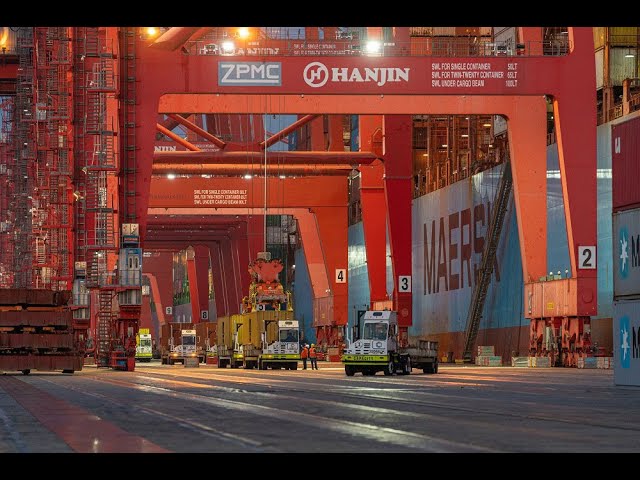Subtotal ₹0.00
The ongoing negotiations between the International Longshoremen’s Association (ILA) and the United States Maritime Alliance (USMX) have hit a significant roadblock over the issue of automation, raising concerns about potential strikes that could disrupt East Coast ports. Understanding the history, core issues, and perspectives of both parties is essential to grasp the complexities of this situation. The Wall Street Journal
A Brief History
The ILA, representing dockworkers along the U.S. East and Gulf Coasts, has a long-standing tradition of advocating for labor rights, fair wages, and job security. The USMX, comprising port operators and shipping companies, focuses on maintaining efficient and competitive port operations. Historically, negotiations between these two entities have been challenging, often centering on wages, working conditions, and technological advancements.
The Core Issue: Automation
At the heart of the current impasse is the implementation of automation in port operations. The ILA expresses concerns that increased automation could lead to significant job losses, threatening the livelihoods of thousands of dockworkers. They argue that while modernization is necessary, it should not come at the expense of employment. On the other hand, the USMX contends that automation is crucial for enhancing efficiency, reducing operational costs, and keeping U.S. ports competitive on a global scale.
Understanding the ILA’s Perspective
The ILA’s primary objectives are to ensure job security and secure fair compensation for its members. They advocate for:
- Job Security: Implementing measures to protect existing jobs and prevent mass layoffs due to automation.
- Fair Compensation: Negotiating wage increases that reflect the rising cost of living and the essential nature of their work.
The argument for higher wages is bolstered by the increased profits that many port operators experienced during the COVID-19 pandemic, driven by surges in shipping demand. The ILA believes that workers who contributed to these gains should receive a fair share of the financial benefits.
Watch: Automation and Robots at LA Ports
Automation vs. Modernization: A Comparison
It’s important to distinguish between automation and modernization:
| Aspect | Automation | Modernization |
|---|---|---|
| Definition | Use of technology to perform tasks with minimal human intervention. | Updating existing systems and processes to improve efficiency and performance. |
| Impact on Jobs | Potential reduction in workforce due to machines replacing human roles. | May require retraining but generally aims to enhance human capabilities. |
| Cost | High initial investment with potential long-term savings. | Variable costs depending on the extent of updates. |
| Flexibility | Can be rigid; systems may not adapt easily to unexpected changes. | More adaptable to changing conditions and demands. |
During crises like the COVID-19 pandemic, ports faced challenges in scaling operations to meet sudden surges in demand. Modernization efforts that enhance flexibility and capacity could address such issues, potentially incorporating selective automation to improve responsiveness without compromising employment.
Lessons from Global Ports
Examining the experiences of European and Asian ports with automation provides valuable insights:
- Pros:
- Increased Efficiency: Automated systems can operate continuously, reducing turnaround times.
- Cost Savings: Over time, automation can lower labor costs and minimize human error.
- Cons:
- Job Displacement: Significant reductions in the workforce can lead to social and economic challenges.
- High Initial Investment: The cost of implementing automation technologies can be substantial.
In the U.S., the impact of automation would vary based on the scale of implementation and the measures taken to mitigate negative effects on employment. While automation can enhance competitiveness, it must be balanced with considerations for the workforce and community well-being.
Comparing the U.S. and China
China’s ports have embraced automation extensively, driven by high cargo volumes and a strategic focus on technological advancement. The scale of operations in Chinese ports often justifies the investment in automation. In contrast, U.S. ports vary in size and capacity, and the decision to automate should consider specific operational needs, economic factors, and social implications.
Ownership and Operations of U.S. Ports
Most U.S. ports are publicly owned by state or local governments, but terminal operations within these ports are often managed by private or foreign entities. For example, the Port of Los Angeles and the Port of Long Beach have terminals operated by companies like APM Terminals and China COSCO Shipping. This structure allows for private investment and expertise while maintaining public ownership of the port infrastructure.
Social Responsibility in Negotiations
Both the ILA and USMX have a stake in addressing broader social responsibilities, including:
- Environmental Impact: Implementing technologies that reduce emissions and promote sustainability.
- Safety: Ensuring that both automated and manual operations adhere to high safety standards.
- Community Employment: Maintaining job opportunities for local communities and supporting workforce development.
Balancing economic objectives with social responsibilities is crucial for sustainable and equitable port operations.
Conclusion

The negotiations between the ILA and USMX highlight the complex interplay between technological advancement and labor rights. Finding a resolution that embraces modernization while safeguarding employment and community interests is essential. By considering the perspectives of both sides and learning from global experiences, stakeholders can work towards a future where ports are both efficient and equitable.


